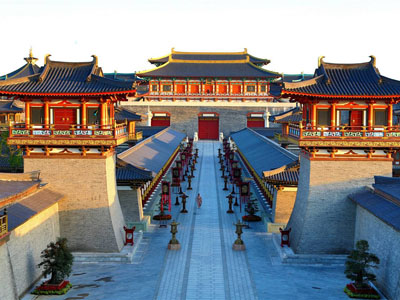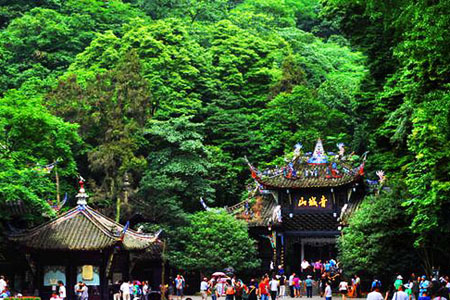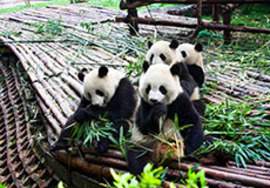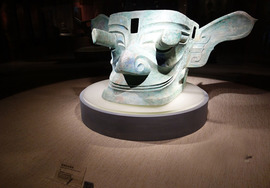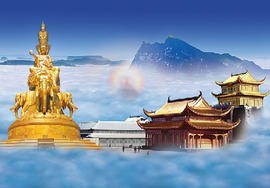When you arrive in the early morning at the Town of Jiuhua,a small town surrounded by forest-cloaked mountains, in Qingyang Country, Anhui Province, east central China,you are impressed by a great number of ancient temples in typical traditional Chinese Buddhist style, and the solitude and serenity, that is interrupted only by the loud chorus of the Buddhists who are reading Buddhist scripture at their daily worship service.
If you enter into the biggest hall in a biggest temple, you can presented with a grand worship service consisting of dozens of monks dressed in orange-yellow kasayas. They are worshiping on bended knees in front of a big golden image of Buddha,with their palms put together, and are reciting Buddhist scripture in chorus that is accompanied by beating drums, wooden fish,small cymbals and small bronze bells. It is a solemn Buddhist hymn or a Buddhist music. The hall is lighted with a number of candles,and the smoke of the burning incenses is curling up from the incense burners. The monks are so devout in the service that nothing outside the service can distract them from the reading.
Buddhist atmosphere pervades this park that inspires feelings of peace and serenity even at its most crowded on its ceremonious occasions and in summertime. A visit in the park gives you glimpses into the history of Buddhism in this area. If you take a self-guided trail and visit the ancient temples both in the small town and over the mountains, they introduce you to the bygone Buddhist culture here.
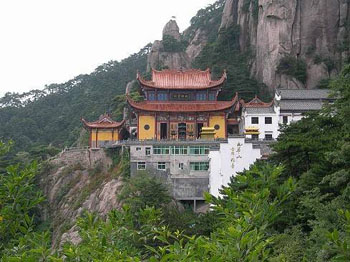
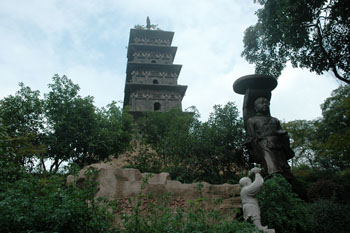
From the fourth year of the Yonghui reign of the Tang Dynasty(653),the Jiuhua Mountains were turned into a place where religious rites were held to worship the God of Earth. In the past thousands of years, a great number (over300) of temples were put up,and over 4,000 monks and nuns had lived here. The increasing numbers of worshipers from all parts of China burnt more and more incenses whose smoke had once filled the air, showing its prime.
The Jiuhua Mountains then became famous the world over as one of the four Buddhist sacred places, or one of the four Buddhist cultural centers in China,the other three Beijng the Emei Mountains of Sichuan Province,the Wutai Mountains of Shanxi Province and the Putuo Mountains of Zhejiang Province. Now, more than 76 ancient temples and over 6,000 Buddha sculptures are preserved here. The most well-known temples here include the Huacheng Temple, the Qiyuan Temple,the Yuegong Hall, the Baisui Temple etc. All of them are in connection with Buddhism here.
Stretching over an area of 100 square kilometers, the Jiuhua Mountains’ are altogether composed of 99 peaks,of which the 9 peaks are the most magnificent ones including the Shiwang Peak,the Tiantai Peak,the Lianhua Peak and the other 5 peaks. Towering 1,342 meters above sea level, the Shiwang Peak,the highest peak among the others,standing majestic and draped with jade-green vegetation, enjoys the reputation of being “the most picturesque peak of the southeast China”.
Nurtured by the warm climate,sufficient rainfall and rich soil,the nine peaks rival each other in beauty and grandeur. The dark green pine stands and the emerald bamboo stands, the cool grottoes and grotesque rocks,the silver waterfalls and the clear streams, the verdant fields and the peaceful villages, all act as an important component of an alluring picture,creating the colorful, fascinating and heart-stopping views.
The great variety of ancient temples,ancient relics and the historic sites here in this park make it a valuable museum for the research into the ancient Buddhism, Buddhist culture and its relationship with the foreign Buddhism. One of the four Buddhist sacred places, and one of the four Buddhist cultural centers in China, the park is one of the important centers for international exchanges of Buddhism. The ancient temples offer precious structures for the research on ancient architectures.
Related Tours:
